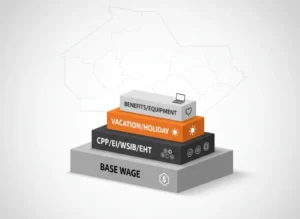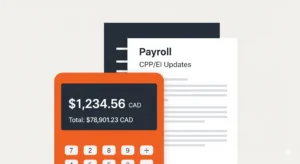The Ontario government has officially confirmed the annual minimum wage increase, which will take effect on October 1, 2025. For business owners and HR managers, this announcement is a critical signal to review payroll, update budgets, and prepare employee communications. The Ontario minimum wage increase 2025 is tied to the Consumer Price Index, reflecting the government’s ongoing effort to help wages keep pace with inflation. But for employers, it’s more than just a new number—it’s a moment to ensure compliance and strategically manage labour costs.
This guide will break down the new rates, explore the ripple effects beyond payroll, and provide a clear, step-by-step action plan to ensure your business is ready for the change.
What Are the New Ontario Wage Rates for 2025?
Effective October 1, 2025, the following minimum wage rates will be legally required for provincially regulated employees in Ontario:
- General Minimum Wage: will increase to $18.00 per hour. This is the rate that applies to most employees.
- Student Minimum Wage: will increase to $17.00 per hour. This rate applies to students under the age of 18 who work 28 hours a week or less when school is in session, or who work during a school break or summer holidays.
- Homeworkers’ Minimum Wage: will increase to $19.80 per hour. This rate applies to employees who do paid work in their own homes for an employer and is set at 110% of the general minimum wage.
It’s important to note that the special minimum wage rate for “liquor servers” was eliminated in 2022. These employees are now entitled to the general minimum wage of $18.00 per hour.
Business Impacts of the 2025 Minimum Pay Increase
While updating payroll is the most obvious task, savvy employers understand that a minimum wage adjustment has broader implications for their operations and workforce management. Ignoring these can lead to unforeseen challenges with morale and retention.
Addressing Wage Compression
One of the most significant side effects of a minimum wage hike is wage compression. This occurs when the pay gap narrows between new, entry-level employees and your more tenured or slightly higher-skilled staff. For example, if a new hire will now earn $18.00, what about the employee with two years of experience who is currently earning $18.50? Their relative pay advantage has shrunk significantly, which can lead to feelings of being undervalued. This can negatively impact motivation and may lead experienced employees to look for opportunities elsewhere.
“A mandatory wage increase is a compliance task, but how you communicate it defines it as either a simple line item or an investment in your team.”
Budgeting, Staffing, and Pricing
An increase in your base pay rate directly impacts your labour costs, and not just for minimum wage earners. Overtime, vacation pay, and public holiday pay are all calculated based on an employee’s rate of pay, so those costs will rise as well. Businesses must factor these increased expenses into their financial forecasts for the last quarter of 2025 and into their budgeting for 2026. This may require a careful review of staffing levels, operational efficiencies, and, in some cases, product or service pricing.
How to Prepare for the Ontario Minimum Wage Increase 2025
Proactive preparation can ensure a smooth transition and help you avoid any compliance missteps with the Ministry of Labour. Taking a strategic approach turns a requirement into an opportunity to reinforce your position as a fair and organized employer.
Step 1: Audit and Update Your Payroll Systems
Well before the October 1 deadline, you must verify that your payroll software or service provider is prepared to implement the new rates. Don’t just assume the system will update automatically.
- Review all employee classifications: Ensure every employee is correctly classified (e.g., General, Student) so the right rate is applied.
- Check automated calculations: Confirm that formulas for calculating overtime, public holiday pay, and vacation pay will correctly use the new, higher base rates.
- Plan the transition: The first pay period that includes hours worked on or after October 1 must reflect the new rate for those specific hours.
Step 2: Communicate Clearly with Your Team
Transparency is key. Don’t let your employees hear about the wage increase through the news or a rumour. Frame the change positively and clearly communicate how it affects them.
Prepare a brief, straightforward memo or announcement for all staff—not just those receiving the increase. Explain that the business is complying with the provincially mandated wage adjustment. This reinforces that you are a responsible employer and keeps everyone informed, preventing confusion and speculation. For those employees whose wages are not changing, it still provides important context.
Step 3: Review Your Full Compensation Structure
Use the Ontario minimum wage increase 2025 as a catalyst to review your entire internal wage grid. As discussed, wage compression is a real risk to morale. Analyze the pay rates of employees who are currently earning slightly above the new minimum wage.
Consider making small, proactive adjustments to their pay to maintain a meaningful gap based on their experience, skills, or responsibilities. While not legally required, this strategic investment can be crucial for retaining valuable employees and maintaining a fair and equitable pay structure.
What Ontario Employers Should Do Next
- Verify & Update Payroll: Immediately audit all employee wage rates and schedule your payroll system to apply the new rates for all hours worked on or after October 1, 2025.
- Prepare Employee Communications: Draft a clear, concise internal memo to be distributed before the end of the month, informing all staff of the upcoming government-mandated wage changes.
- Analyze Your Budget & Pay Equity: Review your Q4 labour cost projections and analyze your internal wage grid for potential wage compression issues that may need to be addressed.
Change is a constant in HR, and staying ahead of legislative updates is what separates a reactive business from a proactive one. This wage increase is a perfect example of a compliance task that, when handled thoughtfully, can support your broader employee relations and retention strategy.
Need help navigating HR changes? Book your free HR audit today or speak with our team about how Divino can support your business.
Sources




